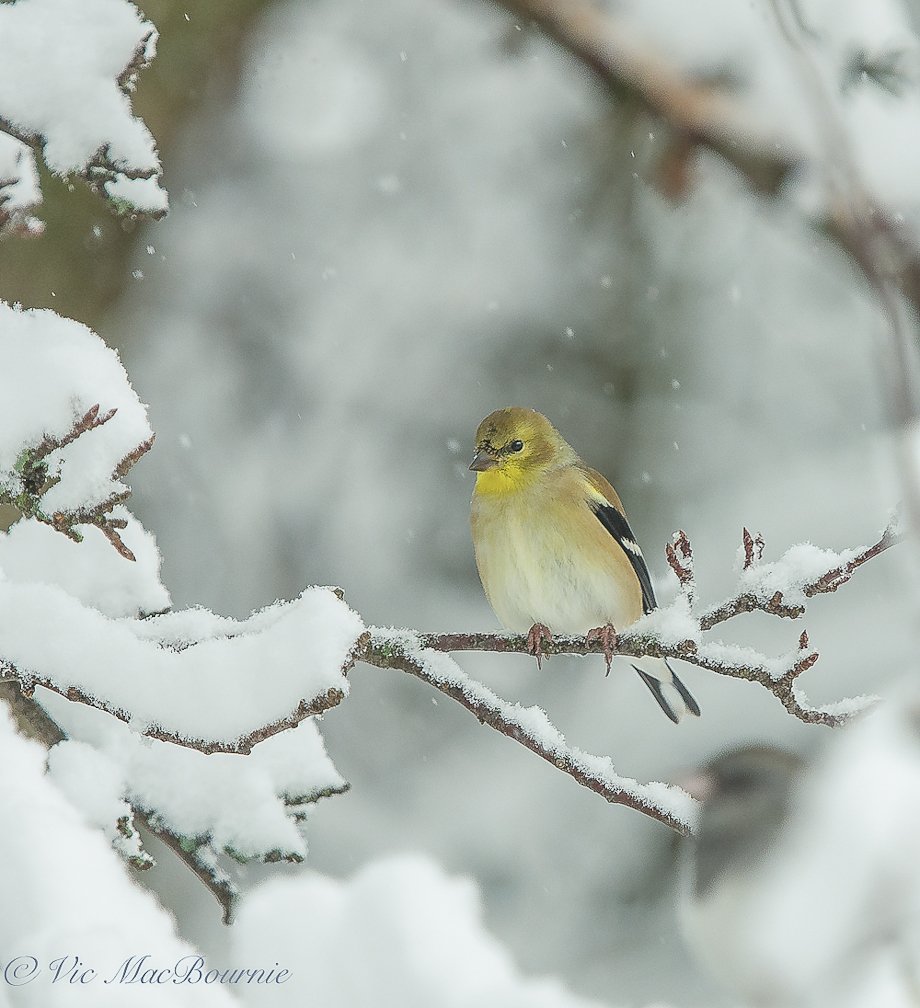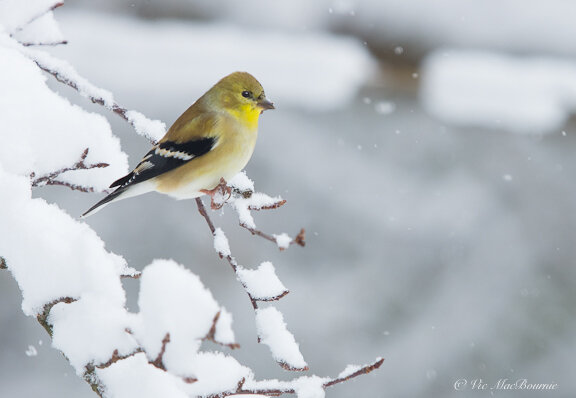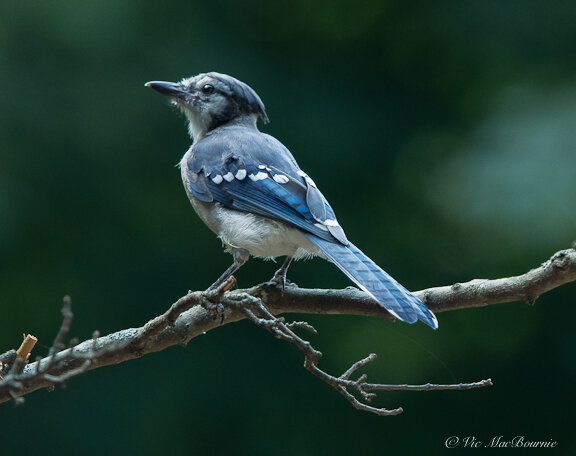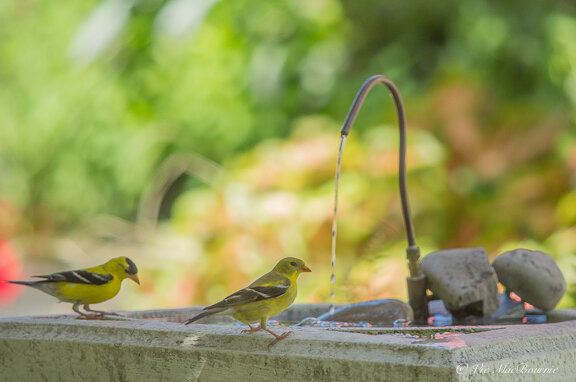How do our bright yellow Goldfinches get their colour
The stunning colour changes of the American Goldfinch is unmatched by most backyard birds. These changes can be traced, in part, to its almost entirely vegetarian diet of seeds, most notably the seeds of thistle, sunflower and milkweed.
A digital watercolour image of an American Goldfinch sitting out a winter storm.
Bright yellow bird’s colour change and the common thistle
The story of the American Goldfinch’s bright yellow colour and why it changes from a drab greyish brown in winter to a stunning bright yellow in early spring really begins with, and is tied to, its diet of almost entirely seeds – primarily seeds from its favourite food, the thistle plant.
If you want these colourful “wild canaries” in your woodland garden, let the thistles grow in a corner of your yard or, if you want to watch these beautiful little finches attack your thistles, plant them near your favourite sitting area or a window. Be sure to include sunflowers and milkweed as well for some spectacular late summer entertainment.
What you will notice is that later in summer these thistles and other native plants will begin to flower and put out seed just in time for the Goldfinches to take advantage of this abundance of seed to feed their, most likely, one and only brood of nestlings.
Okay, so what does this have to do with the male Goldfinch taking on its bright yellow spring colour and the female’s subtle soft yellow coat?
It is thought that the timing of the moult and the transformation into its beautiful yellow plumage in spring is related, at least in part, to natural seed production. The Goldfinch’s late winter/spring moult is unusual because most birds can’t use up that much energy in spring when they are trying to raise their nestlings, but because Goldfinches depend almost entirely on the consumption of seed, they are able to nest later in the season following a spring moult.
American Goldfinches are unusual among goldfinches in moulting their body feathers twice a year, once in late winter and again in late summer. The late summer moult takes place after the nestlings are born and are more independent of their parents.
Of course, the male’s bright colour relates to the mating season, but unlike most birds that begin nesting in early spring timed in part to the explosion of insect and larvae life that feeds their nestlings, Goldfinches breed later and feed its nestlings almost entirely seeds.
Check this link for more on the American Goldfinch and attracting colourful birds to your yard
An American Goldfinch quietly waiting for its turn at the Nyjer bird feeder during an early winter snowstorm that helps explain the bird’s still-vibrant plumage colours.
When do Goldfinches begin nest building?
Goldfinches don’t begin their mating ritual and nest building until later in the summer – June and July in the eastern part of their range and as early as May and June in their western ranges. By this later date, the transformation from drab, easily overlooked birds to the stunning yellow plumage of the males and more subtle yellow of the females is usually completed. In fact, by late April the moult is usually complete and the birds can begin building back any energy lost as a result of the moult.
The birds’ almost entire dependency on small seeds also mean they don’t need to rely on insects. This is particularly helpful during winter months when insects are in short supply and helps explain the fact that few of the birds migrate far distances if at all.
Moving water proves too much of an attraction for these male and female American Goldfinches. The male can be seen with its black cap waiting for its turn in the bird bath.
Cool facts about the Goldfinch
The Cornell Lab of Ornithology, in their informative website, provided some of the following facts:
Goldfinches incorporate the fibrous seeds of thistle and milkweed, which they also use to feed their young, into their nests.
Goldfinches begin moulting in September, and continue for six to eight weeks During this time they molt all of their feathers, ending up with a completely new set of drab-coloured feathers heading into winter.
In the spring, as new body feathers are grown, the males especially transform into bright yellow breeding plumage, but the wing and tail feathers remain from the previous fall.
American Goldfinches are among the strictest vegetarians in the bird world, only inadvertently swallowing an occasional insect.
American Goldfinch nestlings usually leave the nest two weeks after hatching but continue to be fed by the parents for a period of time.
Although American Goldfinches traditionally only have one brood, an experienced couple may have a second brood. In this case the female builds the new nest while the male continues to feed the first brood.
Brown-headed Cowbirds that lay eggs in an American Goldfinch nest can’t survive on the all-seed diet and perish quickly.
The oldest known American Goldfinch was 10 years 9 months old when it was recaptured and rereleased during a banding operation in Maryland.
A Golfinch looks for seed in the Woodland Wildlife garden where it feeds almost entirely on the seed of native plants and trees.
Where do Goldfinches get this bright yellow colour
This cheerful bright yellow plumage of the male Goldfinch and to a lesser degree the females comes from carotenoids in the plants and plant seeds that they ingest.
The Cornell Lab of Ornithology explains in their article on How Birds Make Colourful Feathers that: “Carotenoids are responsible for the bright yellows seen in goldfinches and Yellow Warblers as well as the brilliant orangish yellow of the male Blackburnian Warbler. Carotenoids can interact with melanins to produce colours like the olive-green of the female Scarlet Tanager.”
Some bird species, whose feathers remain the same colour year round, such as the Cardinal, Blue Jay or Chickadee, the annual moult serves to simply refresh their plumage. Others, like the Goldfinch, use the moult as an opportunity to change their colours from vibrant breeding ones to those that help to camouflage them from predators. The bright yellow plumage of the Goldfinch would do little to hide them in the stark winter landscape. For American goldfinch, that means going through a second moult in the spring, to regain their bright breeding colours.
What other natural seeds do Goldfinches eat?
Thistles are not the only seeds eaten by these small birds. Their strong beaks allow them to open an assortment of seeds including another one of their favourites – sunflower seeds. They also eat seeds from asters, wild grasses and several trees including alder, birch, western red cedar and elm.
Most of us are familiar with the popular (but expensive to purchase) Nyjer seed which is used almost exclusively in special feeders to attract these birds. Although most people think Nyjer seed is the seed of the thistle plant, it is actually the similarly small, thin, black seed from the African yellow daisy (Guizotia abyssinica). Though unrelated to the thistle plant, it is high in oil and a popular source of food for the Goldfinch.
What to do if Goldfinches are not eating your Nyjer seed
Nyjer seed should always be purchased from a reputable seller preferably one that has a high seed turnover because older seed quickly dries out and loses its nutritional benefits. If you notice that finches stop eating from your feeder despite the fact it is full of Nyjer seed you may have just recently put out for them, it is likely that the oil in the seed has dried out and it is no longer useful. At that point it is best to dispose of it and purchase new, fresh seed.
In addition, Nyjer seed is easily spoiled when it gets wet. Even condensation building up at the bottom of the tube feeder can cause the seed to go rancid. Replace and clean the feeders on a regular basis to keep the Goldfinches coming back regularly.
If American Goldfinches are coming regularly to your feeder, September and October is a good time to pay particular attention to them. It is at this time of year that they transition from their stunning golden colour to gray.
Once the transformation is complete the Goldfinches can still be identified by their wings which are mostly black with a thick, buffy bar and white edging during flight.
In conclusion
As Woodland Wildlife gardeners we are often told about the importance of using native plants in our gardens to not only help protect these often threatened species, but to provide birds, pollinators and other predators with a critical food source – either pollen and nectar or the protein provided by insects and caterpillars who live off of them.
The American Goldfinch provides the perfect example of how these native plants provide an important source of food in the form of seeds. In fact, the entire life cycle, mating, giving birth, even moulting is dependent in some way on the production of seeds from a specific group of plants and trees.
For the ill informed, these critical plants, namely thistle and milkweed, are not often desirable plants to have in our gardens and are shunned by many traditional “tidy up” gardeners.
Maybe these gardeners would prefer to pay for an endless supply of Nyjer seed to feed the few Goldfinches that are passing through rather than let the birds natural food source grow in a corner of their yard.
Never has it been more important to embrace native plants and because of the dwindling supply of natural seeds you may be doubly rewarded for your efforts to grow these critically important native plants.
How to attract colourful backyard birds (Cardinals, Bluejays, Goldfinches)
Who needs to go to the tropics to see colourful birds when you have them right in your backyard – Cardinals, Bluejays and Goldfinches. This article explains how to attract three of our favourite colourful backyard birds, how to feed them and how to keep them coming back to your yard.
What they eat and how to attract them
A Goldfinch stops by the birdbath to get a drink in the early evening.
When it comes to birds, everyone loves a little colour in their backyards. That’s why the Cardinal, Blue Jay and Goldfinch are among the most desirable birds in our woodland wildlife gardens.
The Cardinal, Blue Jay and Goldfinch are among the easiest, seed-eating backyard birds to attract to your feeders providing you are giving them their favourite foods. Add natural sources of food from berries to insects, nesting habitat, and, of course, a reliable water source and you will create plenty of colour in your backyard.
While I get great enjoyment from my bird feeding stations, providing natural food sources to our feathered friends is always the goal we should aspire to in our gardens. I have written a comprehensive post on feeding birds naturally. You can read about it here.
This image shows the subtle colour of a Goldfinch in winter during a snowstorm.
Of course these three stunners are not the only colourful birds we can attract to our backyards. My favourite colourful additions to the garden is the incredibly colourful Indigo bunting and the orange and black combination of the Baltimore Oriole. These two highly sought after and extremely colourful birds are more difficult to attract to your backyard feeders so I have tackled those in separate articles. (See my earlier stories on attracting Indigo Buntings and Orioles to your garden.)
To read my article on how the Goldfinch gets its stunning colour and how to attract them with native plants? Click here.
In this post, we’ll take a look at the Cardinal, Blue Jay and and Goldfinch: what they eat, where they nest and what little extras we can do to attract them to our backyards.
A male cardinal in a crabapple tree in spring.
Cardinals: everyone’s favourite backyard bird
It’s hard not to fall in love with Cardinals. Their cheerful persistent songs, the male cardinal’s bright red coat of feathers standing out in the landscape, and the buff-coloured female just as beautiful in her muted colours especially after a fresh snowfall.
These are year-round birds in our area and a regular at the feeders spring, summer, winter and fall.
A sure way to keep them around is to always have a supply of black-oil sunflower seeds in the feeders.
I use a no-mess blend of cracked sunflower seed from Wild Birds Unlimited.
Cardinals’ powerful jaws, and curved beaks give them the ability to easily open larger, harder seeds with great ease. They will readily take to not only both types of sunflower seed, but peanut pieces and safflower.
Cardinals are actually one of the few birds who seem tho really enjoy safflower seed. In fact, I have a separate feeder filled with safflower aimed primarily at attracting cardinals.
Cardinals will readily eat from most feeders, but consider providing them with a large platform feeder as well.
Although most of us know the cardinal as a regular visitor to our backyard feeders, seeds are not their only source of food. Like most birds, Cardinals rely on a steady supply of caterpillars and insects in early spring and summer during the mating season and to raise their young.
Host plants for butterfly larvae – including milkweed, coneflowers, goldenrod, black-eyed Susan aster, and lupines – will encourage cardinals into your yard and provide them with sources of protein to raise their young.
Cardinals are also attracted to fruit bearing plants, especially red fruit-bearing plants. The male cardinal actually gets its bright red coat from the carotenoid pigments in the red fruit. Serviceberry is a cardinal magnet in our garden but so too are are the berries of sumac and dogwoods. The red berries of the native Flowering dogwoods are favourites but not the raspberry-type fruit of the Cornus Kousa which is actually eaten by few if any birds.
(If you are considering planting a Serviceberry, be sure to check out my earlier article on this native tree and shrub here.)
The breeding season for the Northern male Cardinal runs from as early as March through to September. The nest, which is often found in dense shrubbery or in branches of smaller trees anywhere from 1-15 feet off the ground, is made up of twigs, bark strips bits of roots and even paper. It is often lined with vines, grass and hair.
Because they are not cavity dwelling birds, they are not attracted to a bird house.
They do, however, enjoy using backyard bird baths. Look for one that is two- to three-inches deep.
A blue jay shows off its stunning colours.
How about those Blue jays?
These guys might be considered bullies at the bird feeder but their incredible colour is just too good for most of us not to attract them to our backyard feeders.
And there isn’t a nut they cannot crack.
Start with a good helping of shelled or unshelled peanuts in a platform feeder and you’ll likely get your share of Blue jays in short order.
Their long, strong black bills are built for cracking open the hardest of nuts. In the forest, it comes in handy making short order of even tough nuts like acorns.
At our feeders, peanuts, large striped sunflower seeds, black oil sunflower seeds and the condensed seed cylinders (wild Birds Unlimited) favoured by Blue Jays and woodpeckers are guaranteed to attract them to your feeders.
Blue Jays are also attracted to corn, grains and suet at our feeders.
If you are looking to feed them naturally, acorns (from the oak tree) are an excellent source of food. Beechnuts (from beech trees) are also among their favourites.
While they are most often seen at our feeders, insects are still an important part of their diets including grasshoppers and caterpillars. The Cornell Lab of Ornithology reports that the stomach contents of Blue Jays studied over the course of a year showed that they contained about 22 per cent insects, with the remainder being acorns, nuts, fruits and grains.
We can’t overlook the fact that blue jays have been known to raid the nests of other birds and eat both the eggs and or the nestlings. If this is something that disturbs you, attracting Blue Jays may not be right for you.
Blue Jays nest from March through July in an open cup of twigs, grass, and sometimes mud, lined with rootlets. The nests are often in the crotch or thick outer branches of coniferous or deciduous trees. The Cornell Lab of Ornithology reports that Blue Jays often set up their nest in all types of forests but most often near oak trees on forest edges. They are quick to nest in both urban and suburban areas where both Oak trees and bird feeders are often in abundance.
Be sure to provide them with a reliable water source as well. A large, deep bird bath (3 inches at its deepest) will be a good source for your local Blue Jays.
Goldfinches at the bird bath with a solar-powered DIY dripper.
Goldfinches: Add a touch of tropical to your backyard
It’s not hard to think of the Goldfinch when Harry Belafonte sings about the Yellow Bird up high in banana tree.
One look at the male or female American Goldfinches in their finest colours is a reminder of how beautiful our local backyard birds are throughout most of the United States and Canada. No need to travel to tropical regions to see colourful birds and hear their lovely song.
More and more of our American Goldfinches remain here year round helped along by numerous bird feeders and seeds from our flower beds and roadside weeds.
These primarily seed-eating birds are drawn to Niger seeds at our feeders. Be sure to provide the small, black seeds in special feeders designed to allow access to the tiny beaks of the finches. Also available are finch socks filled with Niger that are easily hung from trees or a hook at the feeders.
In nature, Goldfinches eat mostly seeds, especially those in the daisy family. Although they do eat some small insects in summer as well as spring buds, bark from twigs, and maple sap, they always come back to seeds.
It’s not uncommon to see them foraging along fence lines in weedy areas gathering the seeds of thistle, grasses and the seeds from elm, birch and alder trees. Consider leaving an area in your garden to grow wild if you want to add a natural feeding source for Goldfinches as well as other birds that depend on these areas as a food and nesting area.
Audubon reports that Goldfinches are late season nesters, timing their nestlings just as daisy-like flowers begin producing seeds.
Nesting occurs mostly during late summer between July and August in deciduous shrubs or trees usually less than 30 feet above the ground. The nest is a compact cup of plant fibres, spiderwebs and plant down.
Goldfinches will readily come to bird baths. Consider a small, shallow one (depth 1-2 inches) for these diminutive colourful birds.
As an affiliate marketer with Amazon or other marketing companies, I earn money from qualifying purchases.











